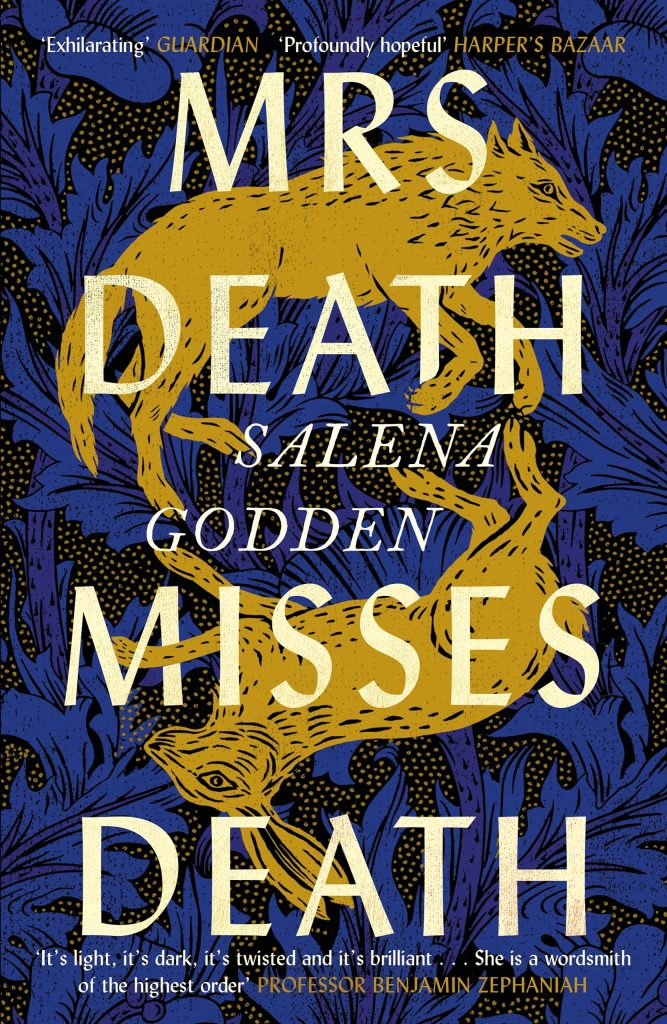Author Salena Godden
Publisher: Canongate
Reviewer: Stephen Keim
Mrs Death Misses Death (“Mrs Death”) was a gift to me by a friend who recognises my propensity for reading and, periodically, tops up my pile of unread books. My friend characterised Mrs Death, on the accompanying card, as Max Porter meets Elif Shefak.
I had very much enjoyed Porter’s Lanny.
I still haven’t read anything by the Turkish/British Shefak although I consider this an omission to be rectified in the future.
Saleena Godden is a British performative poet with a Jamaican and Irish heritage. At time of writing this review, Godden is about to go on a With Love, Grief and Fury performing tour. Mrs Death is her first novel and is described by Godden as partially fiction, partially non-fiction. Published in 2021, it was written mostly during and in lockdown.
The seminal artistic statement of Mrs Death is that, while Death has been, traditionally and universally, portrayed as male (vide the Grim Reaper), death is properly understood as female: “For surely only she who bears it, she who gave you life, can be she who has the power to take it. The one is she. And only she who is invisible can do the work of Death. And there is no human more invisible, more readily talked over, ignored, betrayed and easy to walk past than a woman; than an old black woman, a homeless black beggar-woman with knotty natty hair, broken back, walking ever so slow, slow, slow, pushing a shopping trolley full of plastic bottles.”
Mrs Death has, essentially, two main characters. They are connected by a childhood tragedy. Wolf Willeford is a writer struggling for recognition and living a difficult and chaotic life. Willeford was a child who had just lost his first tooth when his mother died in an apartment fire which Willeford escaped with his life. That night, Willeford, standing on the street shivering in his pyjamas, saw a vision of Mrs Death, a kind black lady smiling down on him even as he screamed in pain and despair.
As the acknowledgments infer, the fire in which Willeford’s mother died is a reference to the Grenfell Tower fire of 2017 which resulted in massive deaths and was caused by the scandalous way in which contractors had been allowed to use highly flammable materials on the 24 storey tower of apartments, thereby, creating a massive fire hazard which wreaked its full potential for death and destruction.
Willeford and Mrs Death are reunited as, now an adult and a writer, Willeford wakes up on a sticky kitchen floor after a days long party and, discovering it is Christmas Eve, walks the streets of London. He finds an antique store in the throes of closing down and writes a note to express his interest in an old desk which he suddenly realises he must have. On the same walk, he is joined by the kindly figure of Mrs Death who leads him on a much more elongated journey through London and regales him with stories of London’s past including its deaths.
The desk turns out to belong to Mrs Death and, through it, Willeford has access to Mrs Death’s secret thoughts and diaries. It is the desk through which he accesses the information he requires to write her memoirs.
Willeford, in an early chapter, described Mrs Death as the collected memoirs of Mrs Death edited and compiled by him. Mrs Death, as it has turned out, is also an anthology or pastiche, containing short stories and poetry, as valuable in their own right as they are in contributing to an overall narrative.
One such short story is of a young girl, Tilly Tuppence, who was exploited by her mother by being rented out to gentlemen to spy on her through peepholes at tuppence a peek. Tilly is linked in an unsuspected way with the young Jack the Ripper.
Another short story involves identical twins, Marsha and Martha, of West Indian heritage who are slaves of a Scottish lord. While one twin was good and mild and the other was bad and mild, yet no one could be sure which one was which.
The title, Mrs Death Misses Death, as well as being an outrageous pun, is also a reference to every occasion in which we escape death by narrow margins. It is a statement that, not every time that Mrs Death comes to collect our soul, is she successful in her function. Sometimes, death is averted. Willeford regards his own survival of the fire which took his mother as just such a miss.
Mrs Death has a high level of philosophical content. Ideas are expressed about how we should view death; how we should treat death; how we should mourn deaths; and how we should speak about death and dying. Mrs Death and, one presumes, Ms Godden, do not like euphemisms like “passed on”. Neither do they like cliches such as “he or she had a good innings”.
The reader suspects, however, that all deaths and all dying are not equal. The deaths of the poor and the put upon are more worthy than those who inflict oppression for the purpose of profit.
The dedicatory pages at the end of the volume include references to those fighting for justice for those who died in Grenfell and to the families of the Windrush generation. The list goes on and includes dedications to those fighting to make a stand for the survival of the planet and to everyone working to save the NHS. Godden is a social activist and her values have rubbed off on the characters of Mrs Death, including Mrs D, herself.
The final pages of Mrs Death contain 23 short poems purportedly written by Willeford in a scary old tower in Cushendall, a small town on the north eastern coast of Northern Ireland as part of an opportunity granted to him by a philanthropist to advance his writing.
It also turns out that Godden had the opportunity to spend time in Curfew Tower in Cushendall to put the finishing touches on Mrs Death. (The Tower is owned by and made available to artists by Bill Drummond, of the Scottish Band KLF.)
The poems reflect their dual purpose containing Willeford’s reflections on his experiences with Mrs Death and the themes thereby raised but, also, deal beautifully with the experience of an artist or writer visiting and working within the environment constituted by the Tower and the town and countryside in which it finds itself.
Mrs Death is an unusual novel. It combines narrative with speculation and philosophy and poetry. We find in the text that Mrs Death’s sister is Life and that her one time lover is Time. In those few fragments, the poetry, philosophy and narrative each finds their respective place.



